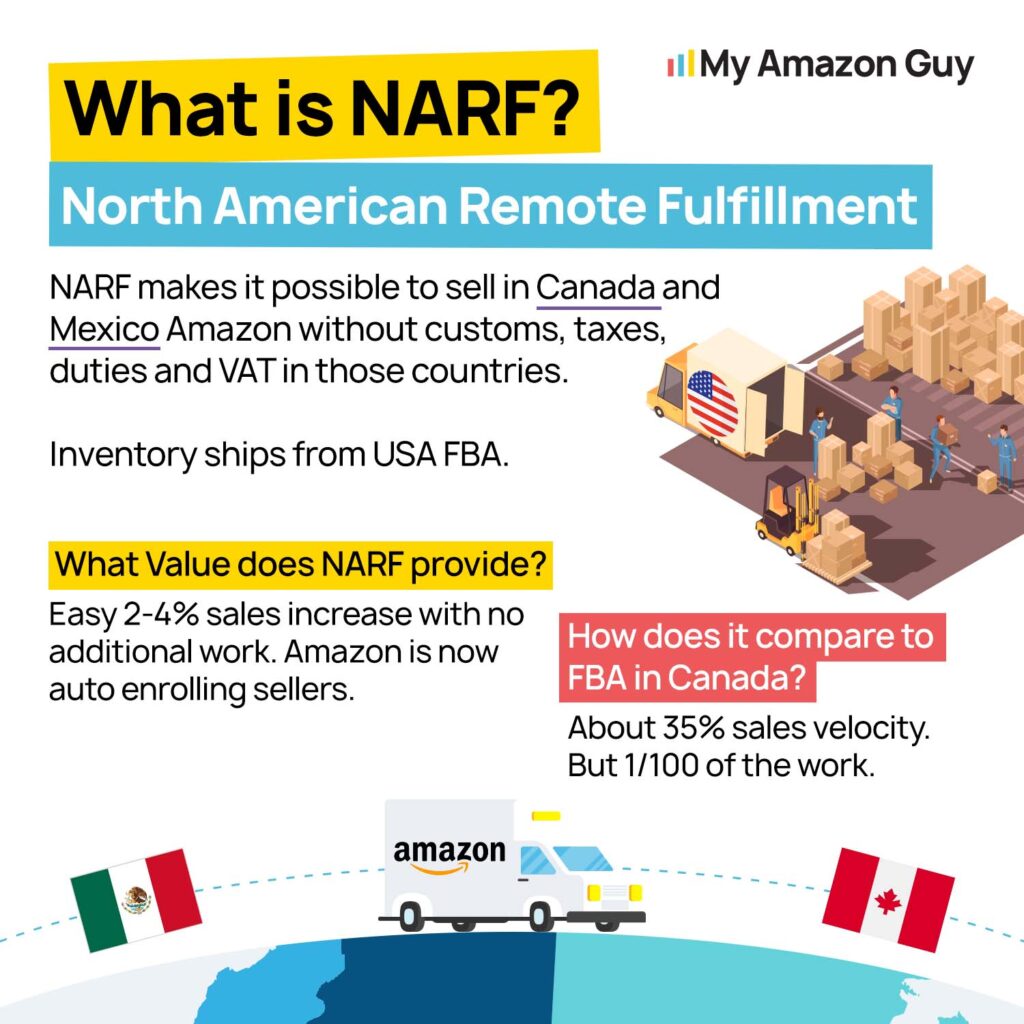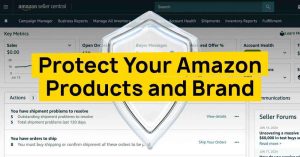
Are you hesitant to expand to Amazon Canada because you’re not sure how things will play out? You might want to test the waters first through the Amazon NARF program, which allows you to sell to Canadian customers using your U.S. FBA inventory.
When sellers start seeing success on Amazon U.S., the next logical step is expansion. The Canadian marketplace is often the first choice because it’s geographically close and full of opportunity. However, many sellers hold back because they don’t know what to expect in terms of fees, logistics, and customer behavior.
That’s where the Amazon NARF program comes in, because it’s a great way to test international demand without committing to sending inventory across the border. But many sellers fall into the “NARF trap” when they underestimate the hidden costs and fail to analyze their data correctly.
In this guide, our Amazon agency explains how the Amazon NARF program lets U.S. sellers test the Canadian market without sending inventory across the border. You’ll also learn the hidden costs, smart strategies, and signs it’s time to transition to full FBA Canada for profitable expansion.
Table of Contents
Maximize Your International Sales
Monitor performance, adjust pricing, and scale strategically to grow your Amazon business across borders.
What Is the Amazon NARF Program and How Does It Work?
The Amazon NARF program (North America Remote Fulfillment) lets U.S.-based FBA sellers list and sell their products on Amazon Canada and Mexico without sending inventory abroad. Instead, Amazon ships orders directly from your U.S. fulfillment centers to international customers.
With over 156 million monthly visitors on Amazon.ca, it’s no surprise that many U.S. sellers want a piece of that market. NARF gives them a low-risk way to test Canadian demand before investing in local warehousing or full FBA Canada operations.
When enrolled in NARF, your U.S. listings automatically appear on Amazon.ca and Amazon.com.mx, priced in local currency. Amazon handles the cross-border shipping, customs paperwork, and customer delivery, making it easy to sell internationally without additional logistics headaches.
The Hidden Costs: Why Many Sellers Fall into the NARF Trap
Still, the Amazon NARF program comes with its own challenges and risks, so sellers shouldn’t jump in without understanding what’s at stake. While it’s a convenient way to expand, it can quickly eat into your profits if you don’t manage it strategically.
- Cross-border shipping costs more, leading to higher FBA fees that shrink profit margins.
- Canadian import fees can drive up product prices and lower competitiveness.
- Currency fluctuations can hurt margins or cause sudden pricing mismatches.
- Shipping from U.S. warehouses often results in slower deliveries for international customers.
- International returns take longer to process and can create cash flow issues if Amazon auto-refunds buyers.
- Products must meet each country’s labeling and safety standards, which adds extra work.
- Copying your U.S. listings without adapting keywords or language can lead to poor conversions.
- A compliance or listing issue on Amazon.ca or .mx can negatively impact your entire seller account.
- Striking the right balance between covering costs and staying competitive across marketplaces is tricky.
- Taxes, shipping, and currency shifts make it hard to forecast true profitability for each sale.
Smart Ways to Use NARF to Test the Canadian Market
To avoid wasting money and hurting your margins, sellers should follow smart strategies when using the Amazon NARF program. Below are proven ways to test the Canadian market effectively without falling into the common NARF pitfalls.
1. Start with a Data-Driven Test
Use NARF as a low-risk way to gauge demand before sending any inventory across the border. Focus on products that already perform well in the U.S. and have potential appeal to Canadian buyers.
Look at your Brand Analytics, geographic sales data, and search term reports to identify products with international traction. This lets you test demand confidently without overcommitting resources or inventory.
2. Test with Low-Risk SKUs
Start your NARF experiment with lightweight, small-sized, and high-margin products to reduce cross-border shipping fees and minimize financial risk. These items are easier to manage and allow you to gauge Canadian demand without tying up too much inventory.
Focusing on low-risk SKUs also helps you analyze performance metrics more clearly, since smaller orders make it easier to track costs, conversions, and customer behavior. Once you see consistent results, you can gradually expand to larger or more complex products with confidence.
3. Understand the Canadian Customer
Before listing, research what Canadian shoppers actually value, such as pricing, seasonal trends, and even cultural nuances can affect conversion rates. Avoid assuming that what sells in the U.S. will perform the same way in Canada.
Take time to understand categories that do well locally, such as home goods, electronics, or health and beauty. Tailoring your listings and offers to match these preferences helps you stand out among sellers who skip this step.
4. Optimize Your Listings for Amazon.ca
Canadian buyers expect listings that feel local and aligned with their values. 46% of Canadian shoppers say they’re more likely to buy from retailers that reduce their carbon footprint, so highlight eco-friendly packaging, recyclable materials, or carbon-neutral shipping whenever possible.
You can also boost visibility and conversions by translating listings accurately, using Canadian English, and including high-volume local keywords. Even small adjustments to spelling, measurement units, and phrasing can make a big difference in click-through and conversion rates.
5. Keep an Eye on Pricing and Shipping
Remember that your listings will show prices in Canadian Dollars (CAD). Keep tabs on exchange rates and adjust pricing as needed to stay competitive while protecting your margins.
NARF shipping times to Canada can range from 7 to 12 days, which is longer than domestic FBA delivery. Manage expectations clearly in your listings and monitor customer feedback to maintain strong account health.
6. Monitor Performance and Optimize
Once your NARF listings are live, don’t “set it and forget it”. Regularly check your metrics, like conversion rate, sessions, and landed costs, to see how your products perform in the Canadian marketplace.
Use that data to make informed decisions on whether to scale your NARF listings or transition to FBA Canada. This analytical approach prevents wasted spend and sets the foundation for profitable international expansion.
Avoid Costly NARF Mistakes
Learn the hidden costs of remote fulfillment and how to optimize your listings for Canadian buyers.
When to Transition from Amazon NARF to FBA Canada
Now, when sellers use the NARF program, how would they know that it’s time to move on to FBA Canada? There are clear signs to watch for, like consistent Canadian orders or stable profit margins even after factoring in NARF fees.
Setting up FBA Canada is the next step once these signals appear. It involves creating a Canadian marketplace account, shipping inventory to Amazon.ca warehouses, and making sure your products comply with local tax and import requirements.
Is It Time to Upgrade from NARF to FBA Canada?
Wondering if it’s the right moment to move from NARF to FBA Canada? Take this quick quiz to see if your products are ready for full-scale Canadian fulfillment.
Frequently Asked Questions
What are the requirements for joining the Amazon NARF program?
You need a Professional Amazon seller account, active FBA inventory in the U.S., and enrollment in the NARF program. Products must comply with Amazon policies and local regulations.
Can I use NARF and FBA Canada at the same time?
Yes, you can run both, but careful inventory management is essential to avoid overselling and account issues.
How long does it take for NARF orders to reach Canadian customers?
Shipping typically takes 7–12 days, depending on the destination and product size.
Do I need a Canadian business number or tax registration for NARF?
Not for testing with NARF alone, but it becomes necessary when you transition to FBA Canada or handle local taxes directly.
Can currency fluctuations affect my profits with NARF?
Yes, exchange rate changes can reduce margins, so regularly monitor pricing and adjust as needed to stay competitive.
Test Canadian Expansion Safely with the Amazon NARF Program
Amazon sellers should always look for ways to improve their reach and sales, since staying stagnant is one of the biggest risks to long-term growth. Expanding into new marketplaces is one of the most effective ways to do this, and Canada is a prime option due to its proximity and large, active customer base.
However, entering a new market can be intimidating, especially without prior experience navigating cross-border logistics, taxes, and local customer preferences. That’s why using the Amazon NARF program is a smart way to test the Canadian market safely, provided it’s done correctly to avoid costly mistakes.
Need help trying out the Amazon NARF program? Reach out to our full-service Amazon agency; our team of experts handles everything from strategy and compliance to logistics and listing optimization, so your international expansion is smooth and profitable.
Expand Your Reach to Canada
Test the Canadian market safely using the Amazon NARF program and gain insights before committing to full FBA Canada.




